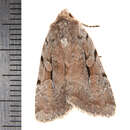Cyclicity
المقدمة من University of Alberta Museums
adults in Alberta from late July through August
- ترخيص
- cc-by-nc
- حقوق النشر
- University of Alberta Museums
Distribution
المقدمة من University of Alberta Museums
Across the forested parts of southern Canada, from NS west to central BC; south to NC and WI in the east, and the Canada-USA border in the west; also in the Cypress Hills. Widespread in the boreal forest, foothills and mountains of Alberta. They are found in coniferous woodlands.
- ترخيص
- cc-by-nc
- حقوق النشر
- University of Alberta Museums
General Description
المقدمة من University of Alberta Museums
A medium size moth (approx. 3.5-4.0 cm wingspan). There are two forms, one a light grey with a purple or pink tint, the other dark purple-grey. Markings consist of doubled dentate antemedian and postmedian lines, often faint or difficult to trace except for a black spot or bar where they meet the costa. The large round orbicular and the reniform spot are filled with slightly paler scales. The area in the cell basad to the orbicular and the lower part between the orbicular and reniform is black. The rest of the area between the reniform and orbicular is partially filled with reddish brown scales and the area beyond the postmedian line is also mixed with reddish-brown, although these may not be obvious. Pale forms are quite powdery and contrasting, while dark specimens appear quite even and smooth. Sexes similar, but males with bipectinate antennae, females with simple antennae.
- ترخيص
- cc-by-nc
- حقوق النشر
- University of Alberta Museums
Habitat
المقدمة من University of Alberta Museums
found in coniferous woodlands
- ترخيص
- cc-by-nc
- حقوق النشر
- University of Alberta Museums
Life Cycle
المقدمة من University of Alberta Museums
Adults are nocturnal and come to light. There is a single brood, with adults in Alberta from late July through August. The larvae is described and illustrated in color in Duncan (2006) They overwinter as partly grown larvae. They are solitary defoliators of a variety of conifers, in particular Englemann, Black and White spruces Douglas-fir, Balsam fir, Jackpine and Lodgepole pine.
- ترخيص
- cc-by-nc
- حقوق النشر
- University of Alberta Museums
Trophic Strategy
المقدمة من University of Alberta Museums
Solitary defoliators of conifers, in particular Englemann, Black and White spruces Douglas-fir, Balsam fir, Jackpine and Lodgepole pine.
- ترخيص
- cc-by-nc
- حقوق النشر
- University of Alberta Museums
Xestia praevia
(
الإنجليزية
)
المقدمة من wikipedia EN
Xestia praevia: Brief Summary
(
الإنجليزية
)
المقدمة من wikipedia EN
Xestia praevia is a moth of the family Noctuidae. It is found in Canada (New Brunswick, Quebec, Manitoba, Saskatchewan, Alberta and British Columbia) south to California. It is part of the elimata species group. Three of the species in this group (Xestia praevia, Xestia elimata and Xestia badicollis) have no significant difference in both genitals and DNA, suggesting they may be in fact one species.
This wingspan is about 32 mm. The moth flies from July to August depending on the location.
The larva feeds on Pinus ponderosa.
Xestia praevia
(
البلجيكية الهولندية
)
المقدمة من wikipedia NL
Insecten Xestia praevia is een vlinder uit de familie van de uilen (Noctuidae).[1] De wetenschappelijke naam van de soort is voor het eerst geldig gepubliceerd door Lafontaine.
Bronnen, noten en/of referenties Geplaatst op:
12-04-2013
Dit artikel is een beginnetje over biologie. U wordt uitgenodigd om op bewerken te klikken om uw kennis aan dit artikel toe te voegen.

Xestia praevia
(
الفيتنامية
)
المقدمة من wikipedia VI
Xestia praevia[1] là một loài bướm đêm thuộc họ Noctuidae. Nó được tìm thấy ở Canada (New Brunswick, Quebec, Manitoba, Saskatchewan, Alberta và British Columbia) phía nam đến California. It is part of the elimata species group. Ba loài trong nhóm này (Xestia praevia, Xestia elimata và Xestia badicollis) không có khác biệt đáng kể về genitals và DNA, cho thấy chúng có thể trên thực tế là một loài.
Sải cánh khoảng 32 mm. Con trưởng thành bay từ tháng 7 đến tháng 8 tùy theo địa điểm.
Ấu trùng ăn Pinus ponderosa.
Liên kết ngoài
![src=]() Phương tiện liên quan tới Xestia praevia tại Wikimedia Commons
Phương tiện liên quan tới Xestia praevia tại Wikimedia Commons
Chú thích
-
^ Bisby F.A., Roskov Y.R., Orrell T.M., Nicolson D., Paglinawan L.E., Bailly N., Kirk P.M., Bourgoin T., Baillargeon G., Ouvrard D. (red.) (2011). “Species 2000 & ITIS Catalogue of Life: 2011 Annual Checklist.”. Species 2000: Reading, UK. Truy cập ngày 15 tháng 6 năm 2014.
- ترخيص
- cc-by-sa-3.0
- حقوق النشر
- Wikipedia tác giả và biên tập viên
Xestia praevia: Brief Summary
(
الفيتنامية
)
المقدمة من wikipedia VI
Xestia praevia là một loài bướm đêm thuộc họ Noctuidae. Nó được tìm thấy ở Canada (New Brunswick, Quebec, Manitoba, Saskatchewan, Alberta và British Columbia) phía nam đến California. It is part of the elimata species group. Ba loài trong nhóm này (Xestia praevia, Xestia elimata và Xestia badicollis) không có khác biệt đáng kể về genitals và DNA, cho thấy chúng có thể trên thực tế là một loài.
Sải cánh khoảng 32 mm. Con trưởng thành bay từ tháng 7 đến tháng 8 tùy theo địa điểm.
Ấu trùng ăn Pinus ponderosa.
- ترخيص
- cc-by-sa-3.0
- حقوق النشر
- Wikipedia tác giả và biên tập viên


Phương tiện liên quan tới Xestia praevia tại Wikimedia Commons